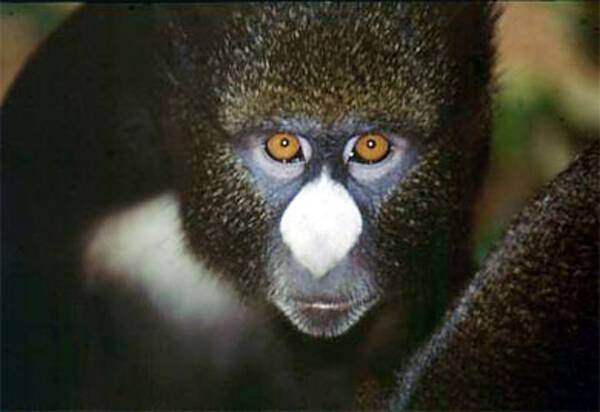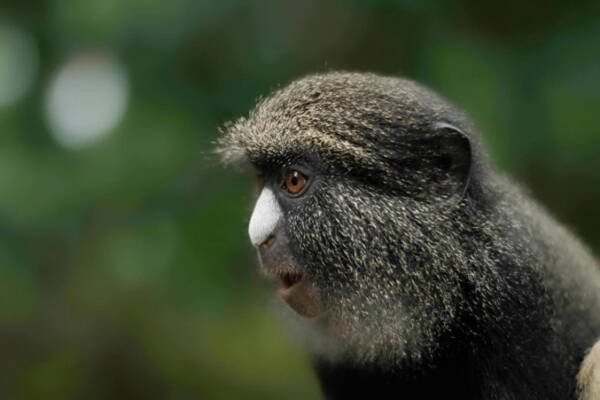Known for its diverse voice
IUCN
LCBasic Information
Scientific classification
- name:Known for its diverse voice
- Scientific Name:Known for its diverse voice
- Outline:Primates
- Family:Cercopithecidae Cercopithecidae
Vital signs
- length:43-70cm
- Weight:4.3-6.7kg
- lifetime:About 20 years
Feature
A striking, bright white patch on the nose
Distribution and Habitat
Distributed in Cameroon, Central African Republic, Congo, Democratic Republic of Congo, Côte d'Ivoire, Equatorial Guinea, Gabon, Liberia and Nigeria.
Inhabits moist tropical lowland and mountain forests, tropical swamps and mangroves, and dense forests in West and Central Africa. Due to its large size, its range is mainly limited to the main canopy of the forest. It rarely descends to the ground.
Appearance
The Great White-nosed Vervet Monkey is the largest species in the genus Vervet Monkey, with a head and body length of 43-70 cm. The female weighs 4.3 kg and the male weighs 6.7 kg. Sexual dimorphism is evident, with males being longer and heavier than females. The name comes from the striking and bright white patch on the nose. The fur is generally black, changing color from olive to dark gray, with white tips. Sometimes there is a white patch on the chest. The limbs, belly and tail are all black. The brain is developed; the eye sockets face forward and the orbital distance is narrow; the toes of the hands and feet are separated, and the thumb is flexible and can be grasped with the other toes. It has cheek pouches and hip calluses; the forelimbs are longer than the hind limbs; the tail is long and can be curled. The nose is short and the sense of smell is inferior to vision, touch and hearing. The tips of the fingers and toes have flat nails, which are plantar. The tail has a prehensi
Details
The white-nosed monkey (scientific name: Cercopithecus nictitans) is also known as Putty-nosed Monkey in English. There are three subspecies.

The white-nosed monkey is usually social, with 12-30 monkeys forming a group. They are mainly active in the middle canopy and often display acrobatic movements such as jumping and soaring. Their habitat overlaps with that of the Diana's monkey. It is thought that the two species form mixed populations for predator defense and shared foraging opportunities. The diet consists mainly of fruits, seeds and leaves, but insects and crops are also eaten.
The Greater White-nosed Monkey, like most primates, has a complex system of hearing, smell, vision and touch. They are particularly known for their diverse vocalizations, with males making loud, low-frequency, intensive calls to declare territory and as a warning to predators; females and adults often use short chirps to attract the attention of the group; infants call loudly when they are separated from their mothers and alert other members of the family group; when encountering leopards, they make a "puff" sound to warn; and when an eagle appears in the sky, they use a cough-like "hix" sound to warn. Moreover, they can use the two sounds of "puyas" and "hiks" to express different meanings in different times and combinations. Therefore, they are regarded as the first animal other than humans to be found to communicate in sentence-like language.

The white-nosed long-tailed monkey has a polygamous mating system, with a resident adult male and several adult females and their offspring in the group. The only male monkey has the right to mate and reproduce with all females. The general monkey king has a term of 5 years. Females show their estrus swelling genitals to males to show that they have reached estrus and strive to mate with them. Females are sexually mature at around 4 years old. The gestation period is 172 days. One offspring is born about every two years. The female monkey will nurse her offspring for about 6 months. Adult females will stay in the monkey group, and male monkeys will drive them away. Lifespan is about 20 years.
Listed in the 2008 Red List of Threatened Species of the World Conservation Union (IUCN) ver 3.1 - Least Concern (LC).
Protect wild animals and eliminate game.
Maintaining ecological balance is everyone's responsibility!
The white-nosed monkey (scientific name: Cercopithecus nictitans) is also known as Putty-nosed Monkey in English. There are three subspecies.

The white-nosed monkey is usually social, with 12-30 monkeys forming a group. They are mainly active in the middle canopy and often display acrobatic movements such as jumping and soaring. Their habitat overlaps with that of the Diana's monkey. It is thought that the two species form mixed populations for predator defense and shared foraging opportunities. The diet consists mainly of fruits, seeds and leaves, but insects and crops are also eaten.
The Greater White-nosed Monkey, like most primates, has a complex system of hearing, smell, vision and touch. They are particularly known for their diverse vocalizations, with males making loud, low-frequency, intensive calls to declare territory and as a warning to predators; females and adults often use short chirps to attract the attention of the group; infants call loudly when they are separated from their mothers and alert other members of the family group; when encountering leopards, they make a "puff" sound to warn; and when an eagle appears in the sky, they use a cough-like "hix" sound to warn. Moreover, they can use the two sounds of "puyas" and "hiks" to express different meanings in different times and combinations. Therefore, they are regarded as the first animal other than humans to be found to communicate in sentence-like language.

The white-nosed long-tailed monkey has a polygamous mating system, with a resident adult male and several adult females and their offspring in the group. The only male monkey has the right to mate and reproduce with all females. The general monkey king has a term of 5 years. Females show their estrus swelling genitals to males to show that they have reached estrus and strive to mate with them. Females are sexually mature at around 4 years old. The gestation period is 172 days. One offspring is born about every two years. The female monkey will nurse her offspring for about 6 months. Adult females will stay in the monkey group, and male monkeys will drive them away. Lifespan is about 20 years.
Listed in the 2008 Red List of Threatened Species of the World Conservation Union (IUCN) ver 3.1 - Least Concern (LC).
Protect wild animals and eliminate game.
Maintaining ecological balance is everyone's responsibility!








